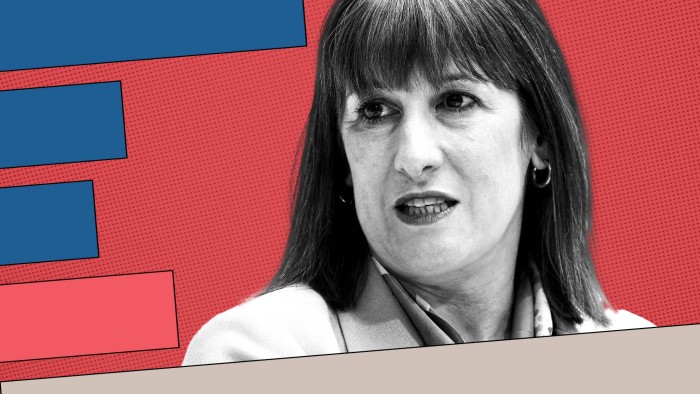Unlock the Editor’s Digest for free
Roula Khalaf, Editor of the FT, selects her favourite stories in this weekly newsletter.
Ministers warned on Wednesday there will be “financial consequences” to confront in the wake of Labour’s costly retreat on welfare, paving the way for potentially significant tax rises in the autumn Budget.
U-turns by the government on welfare, combined with the potential for weaker growth forecasts, could deliver a fiscal hit of as much as £25bn, according to estimates by Capital Economics analysts.
Rachel Reeves has no palatable options for filling that shortfall in the upcoming Budget. “None of this is easy,” admitted one ally of the chancellor, who was visibly upset in the House of Commons on Wednesday.
Which taxes could go up?
Labour’s manifesto ruled out raising income tax, national insurance, VAT or corporation tax. The government’s first Budget nonetheless increased employers’ national insurance contributions by £25bn a year.
Reeves may be wary of trying the same move again given the damage it has done to the labour market. Another option is a form of so-called stealth tax that was favoured by the last Conservative government.
The chancellor could extend a freeze on personal tax thresholds beyond 2028, a revenue raising measure that she declined to take last October, saying that it would hurt “working people”.
If she held the thresholds at which taxpayers pay higher rates on their income for another year rather than increasing them in line with inflation, Reeves would raise £9.2bn, according to the Institute for Fiscal Studies.
Another approach would be to hit businesses and the wealthy with further tax increases. A one percentage point increase in corporation tax would raise £4bn in 2028-29, though Labour has promised not to increase the 25 per cent levy.
Deputy prime minister Angela Rayner earlier this year suggested eight potential tax rises in a memo to the chancellor, including reinstating the pensions lifetime allowance and a higher corporation tax rate for banks. Together the measures would raise £3bn-£4bn a year, the memo said.
Some Labour MPs have urged Reeves to institute a “wealth tax”, a call that has exasperated the chancellor. One ally said: “What do people mean? Can you write it down on a piece of paper?”
A big risk for Reeves is that she is forced to scrabble around for multiple small-scale tax increases because she has ruled out the major revenue raisers. This could distort the tax system even more, undermining the government’s “number one mission” of boosting GDP growth.
Could the chancellor loosen the fiscal rules?
Reeves has described her fiscal rules as “iron clad” and “non negotiable”, although she did not exclude a possible loosening at her autumn Budget when specifically questioned on the idea by Sir Mel Stride, Tory shadow chancellor, on Tuesday.
Reeves has already announced a looser borrowing regime in her first Budget, however, allowing her to borrow an extra £113bn to spend on infrastructure in this parliament. Bond markets are unlikely to respond well if she changes the rules again, only a year later, analysts warned.
Among the possible options for loosening the fiscal rules would be a move to lengthen the time horizon for meeting the current budget rule, which is currently due to shrink from five years to three years during the parliament.
Reeves might also seek to boost her wriggle room by aiming for a deficit of no more than 0.5 per cent of GDP — a scenario that is already in the fiscal rules but only as a temporary holding measure to tide the Treasury over between fiscal events.
Other possible changes might entail a switch in the target, for example to use a measure of the budget balance that is adjusted for the economic cycle, said Ben Zaranko, an economist at the Institute for Fiscal Studies.
But he warned that a second overhaul to fiscal rules that are already loose would go down “very poorly with financial markets” and push up the cost of borrowing for the government.
“Jettisoning the rules at the second opportunity because a government with a majority of 165 can’t get its spending reforms through parliament is unlikely to enhance the government’s reputation for fiscal credibility,” he added.
Many investors see £10bn as the bare minimum headroom Reeves’ needs against her key fiscal rule of funding day-to-day spending with tax revenues.
Anything less would mean the public finances would be easily destabilised by small movements in borrowing costs or growth assumptions.
But even that amount is only a third of the average safety buffer that chancellors have left themselves over the past 15 years.
What about curbing spending?
After the trauma of Tuesday’s welfare debacle, Starmer and Reeves are unlikely to attempt new cuts to the benefits bill any time soon.
Meanwhile Reeves has only just announced a tight Spending Review covering departmental spending for the next three years, which will see real terms average annual increases in day-to-day spending of 1.3 per cent. Some key public services are facing real-terms cuts.
Reeves could pencil in steeper cuts in 2029-30 to help balance the books, but given that there has to be an election by July 2029, that would test investors’ credulity.
Going into the last election the Conservative party was widely accused of presiding over “fiscal fiction” by making its numbers add up via very tight spending plans in the outer years of its forecast.
“Last night’s parliamentary chaos underscores the government’s waning control over public spending,” said Neil Mehta, portfolio manager at RBC BlueBay Asset Management. “Markets will be on high alert over the next months.”





